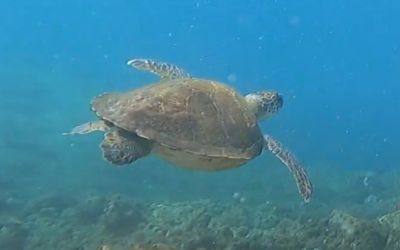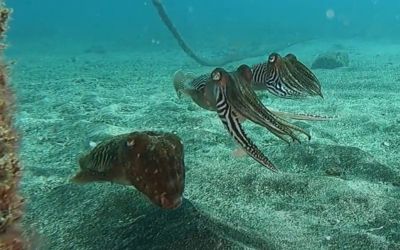
The town of Alcalá is a very popular diving area in Tenerife, especially among local divers and beginners. Below we show you the best areas: the pier of Alcalá and Baja de Alcalá or Los Picachos:
🧭 The best areas to dive in Alcalá
The Alcalá wharf
This dive is done from the shore and is very accessible, with a cement ladder that leads directly to the sea. The depth varies from a few meters below the surface to 20 m, which makes it ideal for initiation and night dives. It is also a perfect place for turtle watching, although they are not always seen.
The most interesting area to dive in Embarcadero de Alcalá is the shallows that can be seen from the surface at empty tide, about 50 meters in front of the stairs. You can go around this shallows to explore the caves and rocks in the area. Green turtles are usually inside the bay and grunts can be found to the left of the shallows.
Baja de Alcalá or Los Picachos
Baja de Alcalá, also known as Los Picachos, is an interesting diving area due to the large number of pelagic species that can be seen, in addition to its underwater landscape with a very rugged topography.
In Baja de Alcalá, one of the most interesting areas to dive is drift diving, as you can enjoy the passage of pelagic species. It is also advisable to explore the shallows, peaks and veriles found in the area, and let the instructor guide you through this labyrinth of solidified lava.
🐠 What marine species can be seen in the area?
- Green turtle: one of the most common sea turtles in the warm waters of Tenerife. They can be easily identified by their dark brown shell and large, broad head.
- Roncador: a long-bodied fish with reddish and silvery shades, which usually forms schools in rocky areas.
- Blackfish: an elongated and slender fish, black on top and silver underneath, which feeds on crustaceans and small fish.
- Carmelita: a fish with a rounded body with brown and orange shades, which usually lives in rocky areas and feeds on small crustaceans and algae.
- Sargo: a fish with an elongated and laterally compressed body, with silvery and golden shades. It feeds mainly on algae.
- Barriguda: a fish with an elongated and slender body, with silvery and golden shades. It feeds on crustaceans and small fish.
- Vieja: a fish with a rounded and flattened body, with brown and black shades, which feeds mainly on algae.
- Octopus: a cephalopod mollusk that can quickly change color to camouflage itself in its environment. It feeds on crustaceans and small fish.
- Choco: a cephalopod characterized by its rounded body and its ability to camouflage itself by changing color. It feeds on crustaceans and small fish.
- Anemones: sessile marine animals that form colonies and attach to rocks and other substrates. They can have various shapes and colors, and provide a habitat for other marine species.
🤿 Diving conditions in Alcalá
The Embarcadero de Alcalá area is very safe and is suitable for all levels of divers. The current is non-existent and the area is sheltered, which makes it a very comfortable place to dive. However, you should be careful with the boats that navigate inside the bay. As for the weather, conditions are ideal 75% of the year, as the bay is sheltered from the NE wind.
On the other hand, the Baja de Alcalá or Los Picachos is a diving area for experienced divers, due to the frequency of moderate to strong currents. It is recommended to carry a decompression buoy and be aware of the weather conditions before the dive. It is advisable to make the dive with a local dive center for an experienced instructor to guide the group.
📍How to get there?
Alcalá is a town in the municipality of Guía de Isora on the island of Tenerife. It is located in the southwest of the island and is accessed mainly by the Autopista del Sur TF-1 and the Carretera General del Sur TF-47.









